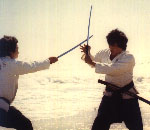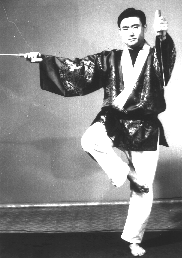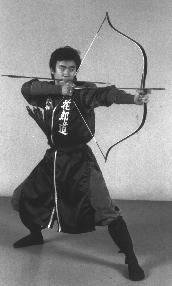HWA RANG DO'S AWESOME WEAPONS ARSENAL
Inside Tae Kwon Do "February 1993 Issue"
There are painfully few weapons used in the Korean martial arts.
The complex art of Hwa Rang Do, however, offers systematic training in 108 different
types of traditional weapons! So many, in fact, they are organized into 20 categories.
Here, a master instructor of this art introduces them to our readers.
The ancient Korean martial art of Hwa Rang Do combines the martial
arts with the Oriental healing arts to form a natural, compatible way of life.
The martial art aspects can be divided into four main divisions of power: 1)
Nae Gong - or internal power development, which is first studied for health
purposes and can later be tapped for power ramifications; 2) Wae Gong - or external
power application, which combines physical movement that can be  characterized
as both tense and linear in nature as well as soft and circular, in over 4,000
distinct techniques; 3) Moo Gi Gong - or weapon power training, and 4) Shin
Gong - or mental power development training.
characterized
as both tense and linear in nature as well as soft and circular, in over 4,000
distinct techniques; 3) Moo Gi Gong - or weapon power training, and 4) Shin
Gong - or mental power development training.
These for power divisions are generally taught concurrently, with the exception
of Moo Gi Gong. Since the weapons taught are an extension of the physical/mental/spiritual
self (due to their potential lethal qualities or the potential to inflict damage
to the practitioner as well as others), Moo Gi Gong training is very specialized
and demands strenuous, consistent practice; special wepon tactics are also taught
to law enforcement, military, security, etc.
There are 108 different types of traditional weapons, with these weapons being
developed as primary tools of war. Since the advent and common usage of the
gun, modern society has less use of such weapons and has spent more time working
on empty-hand methods of self defense.
There are twenty categories of weapons found within the traditional 108 weapons
of the Moo Gi Gong division. These categories include: Types for cutting, poking, throwing, shooting,
slicing, grappling, chopping, spearing, tying, poaching, sticks (short/mid/long),
stabbing, striking, shocking, jointed-weapons, thrusting, fan types, slings,
strung types, and choking types - and are still practiced in their original,
traditional manner.
division. These categories include: Types for cutting, poking, throwing, shooting,
slicing, grappling, chopping, spearing, tying, poaching, sticks (short/mid/long),
stabbing, striking, shocking, jointed-weapons, thrusting, fan types, slings,
strung types, and choking types - and are still practiced in their original,
traditional manner.
The late Michael D. Echanis was one of Supreme Grandmaster Dr. Joo Bang Lee's
premier Hwa Rang Do students. He authored a book series on Hwa Rang Do for the
U.S. military special forces. Due to the lethality (or potential for it) the
publisher pulled the book from the shelves. Dr. Lee directed the shooting for
the book series prior to Echanis' untimely death.
Training in weapons helps to develop mental concentration since the weapon is
an extension of the  human
body. Without proper practice, it is possible to injure oneself or one's partner(s).
Sword practice is considered asthe epitome of weapons training, with stick types
generally being the first type of weapons to be taught, unless the needs of
the situation dictate otherwise. Practicing these weapon types in their traditional
form enables the practitioner to most efficiently utilize any available object
to its' own utmost potential.
human
body. Without proper practice, it is possible to injure oneself or one's partner(s).
Sword practice is considered asthe epitome of weapons training, with stick types
generally being the first type of weapons to be taught, unless the needs of
the situation dictate otherwise. Practicing these weapon types in their traditional
form enables the practitioner to most efficiently utilize any available object
to its' own utmost potential.
The World Hwa Rang Do Association holds periodic seminars on specific weapon
types and their usage (predominantly through its Military Mobile Training Teams
and Law Enforcement Mobile Training Teams, though some seminars are available
to civilians who have the proper credentials).
Modern Applications
Modern-day weapons of self defense include, but are not limited to: Chemical
irritants (such as mace, pepperguard, or any derivative thereof); stunguns,
knives, and of course, a variety of firearms. These popular weapon types all
have their followers and all possess both advantages and disadvantages in their
usage as a primary self defense tool.
In addition to the availability of the weapon and how quickly it can be brought
into action if the need arises, one also has to determine how capable one is
in its execution. Many people buy chemical deterents, stunguns, knives, or firearms
and throw them in a purse or coat pocket thinking that they now have the means
to defend themselves. Without proper training (and in most cases, continual
practice) these "defensive tools" may only escalate the situation
with the victim having these "tools" used against him or her.
It's also important to note that if one makes the decision to even purchase
anything that  has
deadly capability for self-defense, that they can indeed use it in its extreme
capacity. If not, one shouldn't acquire that deadly item, for it probably would
be turned against him.
has
deadly capability for self-defense, that they can indeed use it in its extreme
capacity. If not, one shouldn't acquire that deadly item, for it probably would
be turned against him.
In the aftermath of nearly all cases of self-defense, law enforcement officers
and prosecutors want to see that all avenues of avoidance of deadly use of force
(in an incremental escalation of force) were followed, and that the least serious
use of force to contain the situation at hand was indeed applied. They consider
this with thought given to the severity of the situation, the real threat levels
involved, and victims' ability to defend themselves against the level as carried
out by the assailant(s).
Excluding law enforcement and active military personnel, a majority of people
do not actively carry self-defensive weapons with them wherever they go. If
they do, and they use these weapons offensively (or what can be found in court
to be offensively), they may face severe legal ramifications that may lead to
their own  incarceration
(as well as punitive damages, court and attorney fees, and civil lawsuits).
However, the old adage that, "it is better to be tried by twelve than to
be carried by six" still holds it's degree of truth.
incarceration
(as well as punitive damages, court and attorney fees, and civil lawsuits).
However, the old adage that, "it is better to be tried by twelve than to
be carried by six" still holds it's degree of truth.
By training in the basic use of the 20 categories of weaponry found within the
art of Hwa Rang Do, the practitioner can most effectively utilize any object
as a weapon as the situation deems appropriate. The use of "field expedient"
weapons - such as pens, pencils, books, sticks, rocks or stones, umbrellas,
canes, cups of coffee, tree branches, trash can lids, clothing, adinfinitum
- makes these multitude of potential weapons available to the practitioner of
Hwa Rang Do without having to carry "weapons" with them wherever they
go.
As in the training of the traditional 108 individual weapons, these impromptu
weapons can be an extension of the trained practitioner's self and thus effectively
be used within the specific needs of the self-defensive situation at hand.
For further information regarding the weaponry of Hwa Rang Do or upcoming weapons
seminars, please contact the World Hwa Rang Do Association, Hwa Rang Do World
Headquarters, 13762 Newport Ave. #201 Tustin, CA 92780 . (714) 731-5425(KICK)
 characterized
as both tense and linear in nature as well as soft and circular, in over 4,000
distinct techniques; 3) Moo Gi Gong - or weapon power training, and 4) Shin
Gong - or mental power development training.
characterized
as both tense and linear in nature as well as soft and circular, in over 4,000
distinct techniques; 3) Moo Gi Gong - or weapon power training, and 4) Shin
Gong - or mental power development training.  division. These categories include: Types for cutting, poking, throwing, shooting,
slicing, grappling, chopping, spearing, tying, poaching, sticks (short/mid/long),
stabbing, striking, shocking, jointed-weapons, thrusting, fan types, slings,
strung types, and choking types - and are still practiced in their original,
traditional manner.
division. These categories include: Types for cutting, poking, throwing, shooting,
slicing, grappling, chopping, spearing, tying, poaching, sticks (short/mid/long),
stabbing, striking, shocking, jointed-weapons, thrusting, fan types, slings,
strung types, and choking types - and are still practiced in their original,
traditional manner.  human
body. Without proper practice, it is possible to injure oneself or one's partner(s).
Sword practice is considered asthe epitome of weapons training, with stick types
generally being the first type of weapons to be taught, unless the needs of
the situation dictate otherwise. Practicing these weapon types in their traditional
form enables the practitioner to most efficiently utilize any available object
to its' own utmost potential.
human
body. Without proper practice, it is possible to injure oneself or one's partner(s).
Sword practice is considered asthe epitome of weapons training, with stick types
generally being the first type of weapons to be taught, unless the needs of
the situation dictate otherwise. Practicing these weapon types in their traditional
form enables the practitioner to most efficiently utilize any available object
to its' own utmost potential.  has
deadly capability for self-defense, that they can indeed use it in its extreme
capacity. If not, one shouldn't acquire that deadly item, for it probably would
be turned against him.
has
deadly capability for self-defense, that they can indeed use it in its extreme
capacity. If not, one shouldn't acquire that deadly item, for it probably would
be turned against him.  incarceration
(as well as punitive damages, court and attorney fees, and civil lawsuits).
However, the old adage that, "it is better to be tried by twelve than to
be carried by six" still holds it's degree of truth.
incarceration
(as well as punitive damages, court and attorney fees, and civil lawsuits).
However, the old adage that, "it is better to be tried by twelve than to
be carried by six" still holds it's degree of truth.